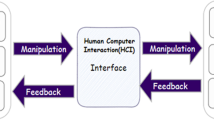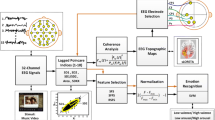Abstract
Electroencephalographic (EEG)-based emotion recognition has received increasing attention in the field of human–computer interaction (HCI) recently, there however remain a number of challenges in building a generalized emotion recognition model, one of which includes the difficulty of an EEG-based emotion classifier trained on a specific stimulus to handle other stimuli. Little attention has been paid to this issue. The current paper is to study this issue and determine the feasibility of coping with this challenge using feature selection. 12 healthy volunteers were emotionally elicited when watching the video clip. Power spectral density (PSD) and brain asymmetry (BAY) were extracted as EEG features. Support vector machine (SVM) classifier was then examined under within-stimulus conditions (samples extracted from one video were sent to both training set and testing set) and cross-stimulus conditions (samples extracted from one video were merely sent to one set, training set or testing set alternatively). The within-stimulus 5-class classification performed fairly well (accuracy: 93.31 % for PSD and 85.39 % for BAY). Cross-stimulus classification, however, deteriorated to low levels (46.22 % and 46.2 % accordingly). Trained and tested with the most robust feature subset selected by SVM-recursive feature elimination (RFE), the mean 5-class performance of cross-stimulus classifier was significantly improved to 68.89 and 64.44 % for PSD and BAY respectively. These results suggest that cross-stimulus emotion recognition is reasonable and feasible with proper methods and brings EEG-based emotion recognition models closer to being able to discriminate emotion states in practical application.





Similar content being viewed by others
Explore related subjects
Discover the latest articles, news and stories from top researchers in related subjects.References
Alm CO, Roth D, Sproat R (2005) Emotions from text: machine learning for text-based emotion prediction. Paper presented at: Proceedings of the conference on Human Language Technology and Empirical Methods in Natural Language Processing (Association for Computational Linguistics)
Balconi M, Lucchiari C (2006) EEG correlates (event-related desynchronization) of emotional face elaboration: a temporal analysis. Neurosci Lett 392:118–123
Baumgartner T, Esslen M, Jäncke L (2006) From emotion perception to emotion experience: emotions evoked by pictures and classical music. Int J Psychophysiol 60:34–43
Chang CC, Lin CJ (2011) LIBSVM: a library for support vector machines. Acm Trans Intell Syst Technol 2:389–396
Edwards J, Jackson HJ, Pattison PE (2002) Emotion recognition via facial expression and affective prosody in schizophrenia: a methodological review. Clin Psychol Rev 22:789–832
Guyon I, Elisseeff A (2003) An introduction to variable and feature selection. J Mach Learn Res 3:1157–1182
Henriques JB, Davidson RJ (1991) Left frontal hypoactivation in depression. J Abnorm Psychol 100:535
Hidalgo-Muñoz A, López M, Pereira A, Santos I, Tomé A (2013) Spectral turbulence measuring as feature extraction method from EEG on affective computing. Biomed Signal Process Control 8:945–950
Köchel A, Plichta MM, Schäfer A, Leutgeb V, Scharmüller W, Fallgatter AJ, Schienle A (2011) Affective perception and imagery: a NIRS study. Int J Psychophysiol 80:192–197
Khalili Z, Moradi M (2008) Emotion detection using brain and peripheral signals. Paper presented at: Biomedical Engineering Conference, 2008 CIBEC 2008 Cairo International (IEEE)
Kim J, André E (2008) Emotion recognition based on physiological changes in music listening. Pattern Anal Mach Intell IEEE Trans 30:2067–2083
Koelstra S, Muhl C, Soleymani M, Lee J-S, Yazdani A, Ebrahimi T, Pun T, Nijholt A, Patras I (2012) Deap: a database for emotion analysis; using physiological signals. Affect Comput IEEE Trans 3:18–31
Koelstra S, Yazdani A, Soleymani M, Mühl C, Lee J-S, Nijholt A, Pun T, Ebrahimi T, Patras I (2010) Single trial classification of EEG and peripheral physiological signals for recognition of emotions induced by music videos. In: Yao Y, Sun R, Poggio T, Liu J, Zhong N, Huang J (eds) Brain informatics. Springer, Berlin, Heidelberg, pp 89–100
Lotte F, Congedo M, Lécuyer A, Lamarche F (2007) A review of classification algorithms for EEG-based brain–computer interfaces. J Neural Eng 4:R1–R13
Peng H, Long F, Ding C (2005) Feature selection based on mutual information criteria of max-dependency, max-relevance, and min-redundancy. Pattern Anal Mach Intell IEEE Trans 27:1226–1238
Picard RW, Vyzas E, Healey J (2001) Toward machine emotional intelligence: analysis of affective physiological state. Pattern Anal Mach Intell IEEE Trans 23:1175–1191
Tomarken AJ, Davidson RJ, Wheeler RE, Kinney L (1992) Psychometric properties of resting anterior EEG asymmetry: temporal stability and internal consistency. Psychophysiology 29:576–592
Verma GK, Tiwary US (2014) Multimodal fusion framework: a multiresolution approach for emotion classification and recognition from physiological signals. Neuro Image 102:162–172
Wang X-W, Nie D, Lu B-L (2014) Emotional state classification from EEG data using machine learning approach. Neurocomputing 129:94–106
Yohanes RE, Ser W, Huang GB (2012) Discrete Wavelet Transform coefficients for emotion recognition from EEG signals. Paper presented at: Engineering in Medicine and Biology Society (EMBC), 2012 Annual International Conference of the IEEE (IEEE)
Acknowledgments
This research was supported by National Natural Science Foundation of China (No. 81222021, 61172008), National Key Technology R&D Program of the Ministry of Science and Technology of China (No. 2012BAI34B02) and Program for New Century Excellent Talents in University of the Ministry of Education of China (No. NCET-10-0618).The authors sincerely thank all subjects for their voluntary participation.
Author information
Authors and Affiliations
Corresponding authors
Rights and permissions
About this article
Cite this article
Liu, S., Tong, J., Meng, J. et al. Study on an effective cross-stimulus emotion recognition model using EEGs based on feature selection and support vector machine. Int. J. Mach. Learn. & Cyber. 9, 721–726 (2018). https://doi.org/10.1007/s13042-016-0601-4
Received:
Accepted:
Published:
Issue Date:
DOI: https://doi.org/10.1007/s13042-016-0601-4




